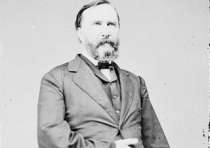
On Jan. 17, 1864, Confederates drove Union forces from the area, but they failed to capture the federals as they fled.
Federal troops, commanded by Maj. Gen. John Parke, moved toward Dandridge on January 14 in search of forage. Confederate Lieut. Gen. James Longstreet ordered two divisions of infantry to head toward Dandridge and his remaining two divisions to march along the railroad toward Mossy Creek in case the Federal movement towards Dandridge was a feint. Longstreet ordered his cavalry, commanded by William Martin, to also head for Dandridge.
The southern commander sensed an opportunity to bring the Federal army to battle, and perhaps destroy it, while also safeguarding a vital foraging area.
Federal cavalry, commanded by Brig. Gen. Samuel Sturgis, reached Dandridge on January 15 before Martin’s cavalry arrived. Sturgis planned to ambush Martin the next day and destroy his force with a double envelopment, but this planned failed. Thus the remainder of Parke’s army concentrated in and about Dandridge on the evening of January 16 as Longstreet’s troops arrived.
Fearing that reinforcements from Virginia had reached Longstreet, Federal commanders decided during the night of January 16 to stay on the defensive. In the morning, Longstreet delayed his attack until noon because he did not have an accurate idea of Federal strength. When the Confederates finally attacked, the Union divisions put up a stout defense but were ultimately forced to retreat. As darkness settled over the area, all remaining advanced Federal units retreated to the safety of their main line. Longstreet had pushed the Federals from the hills before Dandridge when darkness halted the fighting.
General Parke decided to retreat immediately, and his army was gone before midnight. The Federal army retreated in good order; Longstreet’s troops, many without shoes, could not effectively pursue in the frigid winter weather. Longstreet sent Martin’s cavalry in pursuit, but his cavalry commander was slow in pressing the Federals, who withdrew essentially untouched all the way back to Knoxville. Longstreet’s army returned to winter quarters around Morristown and Russellville. Confederate casualties totaled about 150 men, Union losses about 100.
Tools
Key Facts
- Sturgis's plan to ambush Martin's cavalry failed, but Union troops stayed on the defensive.
- Longstreet's troops, many without shoes, were unable to pursue Parke's Federals in good time.
- Federals withdrew, mostly untouched, to Knoxville.




